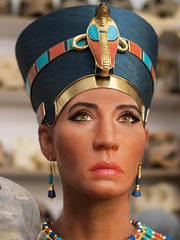The Younger Lady, also known as KV35YL, was discovered in the Valley of Kings in Luxor, Egypt. Recent DNA testing has indicated that she could have been Sitamen, Isis, Henuttaneb, Nebetah or an unknown daughter ofAmenhotep III and Tiye, but she is probably a sister of Akhenaten. The mummy is currently on display at the Egyptian Museum in Cairo, Egypt.
Studies[]
The mummification style and location of burial shows that she was of high status. The Younger Lady has a gaping wound on the left side of her face. It had long been been thought that this wound had been the result of actions of the tomb robbers, but a recent re-examination of the mummy determined that the wound could have happened prior to death, and that the injury had been fatal.
She was between 25 and 35 years old when she died. She was 5 foot 2 inches tall and quite thin, she also had a double piercing on her left earlobe .
The mummy was found in KV35 beside the mummies of a young boy who died at around the age of ten, thought to be either Webensenu or Prince Thutmose, and an older woman, identified as Queen Tiye by recent DNA studies. All three were found lying side-by-side, uncovered, and unidentified, in a small antechamber of the tomb. All three mummies had been extensively damaged by ancient tomb robbers.
Upon finding the Younger Lady, Victor Loret had initially believed it be of a young man as the head had been shaved. A closer inspection later made by Dr. Grafton Elliot Smith confirmed that the mummy was that of a female, though Loret's original speculation lingered for many years.
Since her discovery, there have been many studies done to identify of the Younger Lady. Autosomal and mitochondrial DNA tests have suggested the possibility that Younger Lady was the mother of Tutankhamun, and that she was a child of Amenhotep III and Queen Tiye.
Mummification[]
There is a large defect in the anterior wall of the Younger Lady's torso where the internal organs were removed, save the heart, which is still intact in her body. In and on the torso there are linen fibers treated with resin.
The workers who mummified Younger Lady made no attempt to remove her brain, which was unusual for the period in which she died. On top of the acial gap caused by trauma, there is an embalming pack of linen impregnated with resin. This was also found on the right side of her face, her orbits, her naval cavity and her mouth.
Pathology[]
Researchers found that she had a slight lumbar scoliosis in her spine.
Additional[]

Facial reconstruction by paleo-artist Elisabeth Daynes.
Some suggest that she is Meritaten, wife of Smenkhare. Egyptologist Willeke Wendrich, believes that she was a concubine of Akhenaten, and not his queen. There is no memorabilia in Tutankhamen's tomb relating to the Younger Lady.
DNA test results have shown that the Younger Lady mummy was the mother of Tutankhamun, and by extension a wife or concubine of Akhenaten. The results also show that she was a full sister to her husband, and that they were both the children of Amenhotep III and Queen Tiye. This family relationship rules out the possibility that the Younger Lady was Kiya, because no known artifact accords Kiya the title or attribute "god's daughter." For similar reasons Nefertiti is also ruled out. The report concludes that either Nebetah or Beketaten, younger daughters of Amenhotep III, who are not known to have married their father, are the most likely candidates for the identity of the Younger Lady mummy.
External Links[]
https://www.nationalgeographic.com/magazine/2010/09/tut-dna/
References[]
Hawass, Z; et al. (2010). "Ancestry and pathology in King Tutankhamun's family". JAMA. 303 (7): 3. doi:10.1001/jama.2010.121. PMID 20159872.
